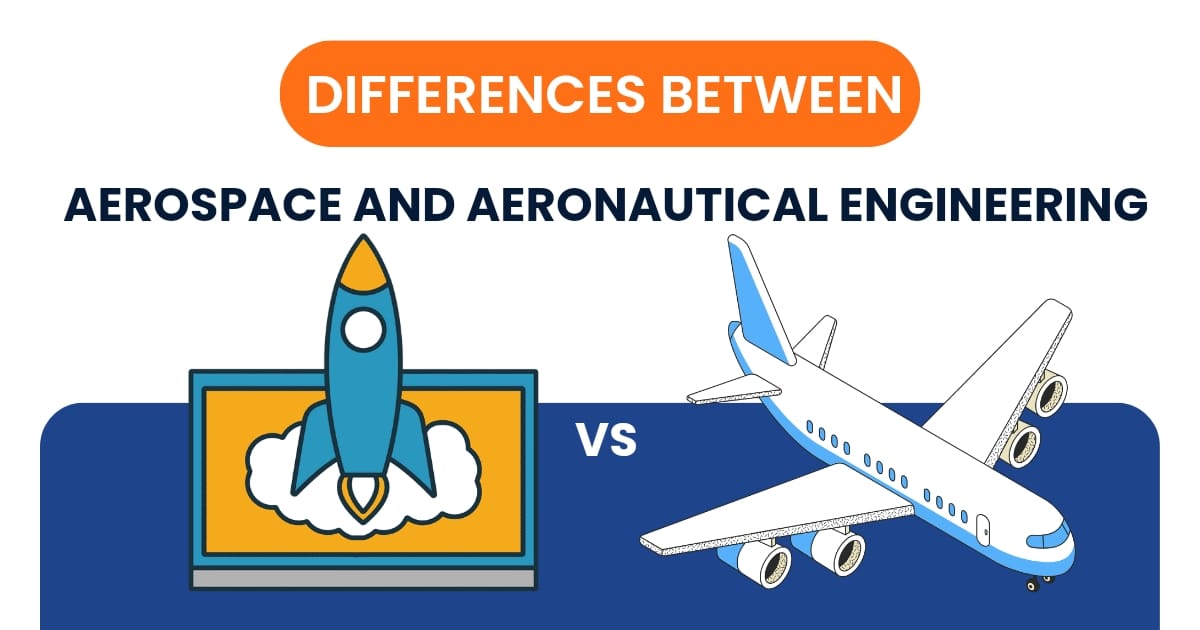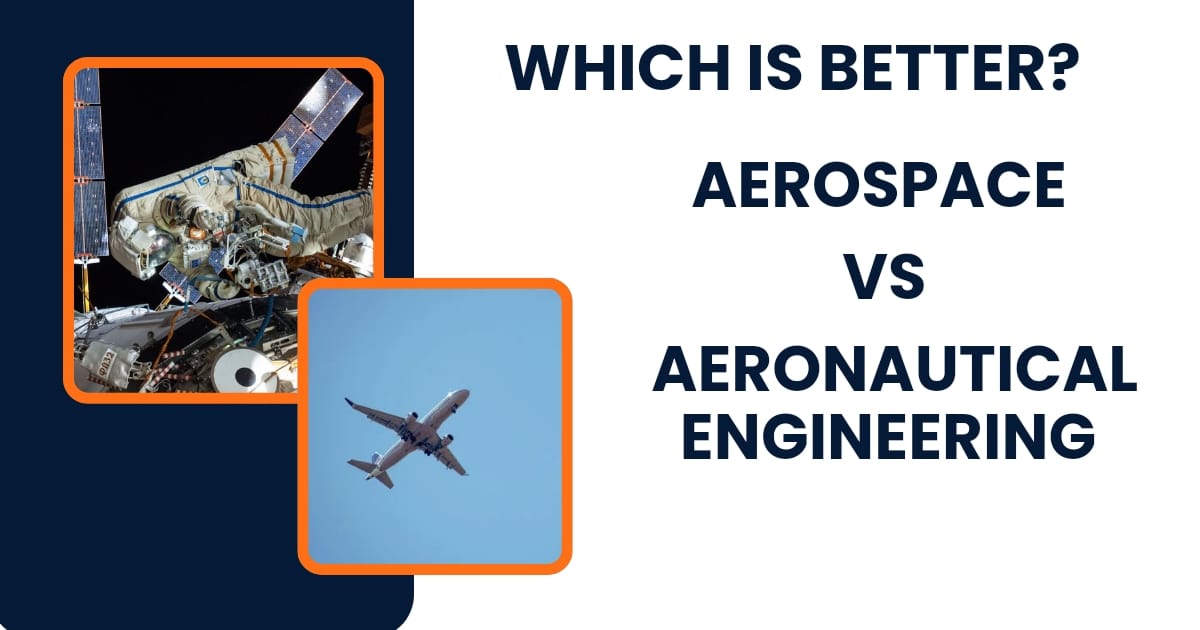Lists of GCSE Maths Topics
Want to know what GCSE Maths topics you have to study for your exams? Maths is really a great choice for your GCSE, as i ...

Aerospace engineering is the field of engineering that includes the development and design of aircraft and spacecraft. Aerospace engineering has two branches: aeronautical engineering, and astronautical engineering.
In this blog, we will briefly discuss the major points of aeronautical and aerospace engineering and the difference between aeronautical engineering and aerospace engineering.
Aerospace refers to aerospace or outer space. Aerospace engineering mainly focuses on designing, developing, maintaining, testing, and originating aircraft, spacecraft, missiles, and related systems and pieces of equipment. This field typically concentrates on problems and solutions related to spacecraft.
It has two overlapping branches: aeronautical engineering and astronautical engineering. Aerospace engineering assignments are a necessary thing for an in-depth study of critical and large concepts of aerodynamics, propulsion systems, and structural analysis
Aerospace engineers develop innovative technologies for use in aviation, defense systems, and spacecraft. They may focus on areas such as aerodynamic fluid flow; structural design; guidance, navigation, and control; instrumentation and communication; robotics; or propulsion and combustion. They work on wide projects like designing and developing airplanes, helicopters, missiles, fighting jets, etc.

Aeronautics is a term that relates to the science or practice of designing/ developing or evaluating aircraft. Aeronautical engineering is a field where engineers concentrate on designing, developing, maintaining, testing, and originating aircraft and understanding their propulsion.
It is an important part of engineering that assures safety, security, efficiency, and elaboration of air travel and transportation.
The aeronautical engineering branch of aerospace engineering also includes astronautical engineering, where engineering focuses on designing, developing, maintaining, testing, and producing spacecraft, such as rockets, missiles, spaceships, and their software, and ensures that it is functioning according to design.
Now, here we will discuss all the similarities and dissimilarities of aerospace and aeronautical engineering according to various domains such as education, work environment, skills, job opportunities, and much more.
The biggest and easy-to-understand difference between Aerospace engineering and Aeronautical engineering is that aerospace is a wider field than aeronautics because aeronautical engineering focuses on aircraft that fly within gravitation force or we can say earth space, whereas aerospace focuses on spacecraft that work beyond gravity.
Knowledge of project management is essential in all branches of aerospace engineering to ensure that work gets done on time and that collaboration between different engineering groups runs smoothly.
Aeronautical Engineers and Aerospace Engineers have similar salaries. According to the US Bureau of Labor Statistics, as of 2021, the average annual salary for aerospace engineers, which includes aeronautical engineers and astronautical engineers, was approximately $122,270.
The salaries of Aeronautical Engineers have been carefully examined, revealing some variation depending on other factors.
To be eligible for aeronautical or aerospace engineering you should pursue a bachelor's degree in aerospace engineering, you typically need to appear for high school with Physics, Chemistry, and Mathematics (PCM). You may also need to have passed a 3-year Engineering Diploma or degree in aerospace branch from a government-approved university for both aeronautics engineering you need to graduate with aeronautics engineering degree.
The methods and devices used in the practical application of the aerospace industry come under aerospace technology. In the final year of aerospace engineering, you are required to submit a dissertation of what you get from your 4 years of degree course then you can take the help of a dissertation writing service. If you are in search of some vocational courses such as level 5 of HND/ HNC, you will get help from HND assignment help.
Foundation Year: Both aeronautical engineers and aerospace engineers have a strong background in physics and mathematics.
Graduation and PG Course Duration: All those students who want to be an aeronautical or aerospace engineer are required to graduate with BEng., a 3-year course (4 with placements). And masters with MEng., 4 year course (5 with placements).
Key Topics: For aeronautical engineers, key points are aerodynamics, propulsion systems, aircraft structures, flight mechanics, and aircraft maintenance. Whether key points for aerospace engineers, aerodynamics, propulsion systems, avionics, space systems, satellite design, and computational fluid dynamics (CFD).
You can also consider other qualifications and training options for both aeronautical and aerospace engineering, such as:
Both aeronautical engineers and aerospace engineers can work in similar environments. An aerospace engineer and an aeronautical engineer can also work in a laboratory to test materials or in an isolated area to test aircraft, spacecraft, and other technology.
They both typically work in an office setting, such as a warehouse, often using a computer. Sometimes, they experience loud sounds and noise levels that are harmful to the ear, so they wear ear protection.
The workplace of an aeronautical engineer is centered around a cockpit, and there is a designated workstation specifically designed for engineers. Both aerospace and aeronautics engineers are involved in high-pressure situations, strict deadlines, and complex projects.
They may conduct field tests and site visits to assess the aircraft or spacecraft. If anyone wants to study in-depth about aeronautical and they can take help with engineering assignments with the assignment helpers.
Here are the differences between Aerospace and Aeronautical engineering skills.
|
Aerospace Engineer Skills |
Aeronautical Engineer Skills |
|
Decision making |
Must be able to understand the project design |
|
Operations analysis |
Business and communication skills |
|
Problem-solving |
Strong mathematical and physics background |
|
Critical thinking |
Creative and Critical thinking |
|
Analytical thinking |
Understanding of various algorithms |
|
Strong mathematical background |
Problem-solving |
|
Expertise in spacecraft and designing the structure |
|
|
Proficiency in orbital mechanisms and algorithms |
Work responsibilities of aeronautical and aerospace engineers are required to work according to their industries. The following are their job responsibilities:
|
For aeronautical engineers: |
For Aerospace Engineers: |
|
Aeronautical engineers work on aircraft that can fly in Earth’s atmosphere. |
Aerospace engineers work on spacecraft that can fly beyond Earth’s atmosphere for a particular mission. |
|
Designing and analyzing aircraft components. |
Designing and analyzing spacecraft and satellite components. |
|
Developing aerodynamics, their software, and simulations. |
Developing aerodynamics, their software systems to explore the missions. |
|
Testing the performance of their developed model. |
Managing orbital trajectory calculations and limitations. |
|
Collaborating with their teams on their aircraft project. |
Evaluation of the performance of that spacecraft in space. |
|
Collaborating with scientists, astronauts, and engineers from different principles. |
|
Aerospace engineering is a wide field where aerospace engineers can be employed by: |
Aeronautical Engineering is a wide field where Aeronautical engineers can be employed by: |
|
Academic researcher |
Manager, Air Traffic Control |
|
Aerospace engineer |
Skilled Aircraft Fitter (engineering/manufacturing experience) |
|
CAD Technician |
Skilled Aircraft Fitter (Night Shifts) |
|
Design Engineer |
Skilled Aircraft Fitter (HVAC Technician experience) |
|
Electronics Engineer |
Lecturer – Aeronautical Engineering |
|
Higher education lecturer |
Graduate - Engineering Technical |
|
Maintenance Engineer |
|
|
Manufacturing Systems Engineer |
The following are the companies that are the best employers of aeronautical engineers and aerospace engineers in the UK
There is not much difference b/w aeronautical and aerospace engineers, who have the most similar salaries.
The average updated salary for an Aeronautical Engineer may be £39,068 per year in the United Kingdom. The highest salary for an Aeronautical Engineer in the United Kingdom is about £51,608 per year.
The estimated salary for an Aerospace Engineer is about £43,617 per year, in the United Kingdom. And the highest salary of an aerospace engineer is about £52,596 per year.
Both Aeronautical engineering and aerospace engineering are wide career fields that needs a large quantity of attention to be advanced along modern technology of air and air space travel and missions. It is not just about designing the aircraft and spaceships but also about their development and system performance which also needs excellent knowledge. To understand what is best and suitable to pursue, it is important to know your passion for a particular course, and knowledge of the opportunities in both fields
Aerospace engineers look after for designing, developing, testing, and evaluating the performance of spacecraft and spaceships in space.
Aerospace engineering is a broader field that includes both aeronautics and astronautics. Aerospace engineers can work in aerospace companies, space agencies, satellite manufacturers, and research institutions. Aerospace engineering offers broader career opportunities than aeronautical engineering. Whereas Aeronautical engineering focuses on aircraft design and operations within the Earth's atmosphere. Aeronautical engineers can work in aerospace companies, defense organizations, and research institutions.
Here are some top universities to study aeronautical engineering and aerospace engineering: 1. University of Bath 2. Imperial College London 3. University of Bristol 4. University of Leeds 5. University of Southampton 6. Durham University
Yes, Aerospace engineers can lead both responsibilities of aerospace and aeronautical engineering because aeronautical engineering is a branch of aerospace engineering so they (aerospace engineers) are taught both aeronautics and astronautics in their education.
To be an Aerospace engineer after high school first, you should take UG course of 4 years from an approved university. After taking the degree of UG course you should try for the PG course which takes 5 years (1 year for placement).
An aeronautical engineer designs, develops, tests, and maintains the performance of an aircraft. While pilots are trained to run aircraft in sky. Yes, an aeronautical engineer can run airplanes but it requires some additional training and certification which is beyond engineering and an engineering degree.
Let's Book Your Work with Our Expert and Get High-Quality Content

Loved reading this Blog? Share your valuable thoughts in the comment section.
Add comment